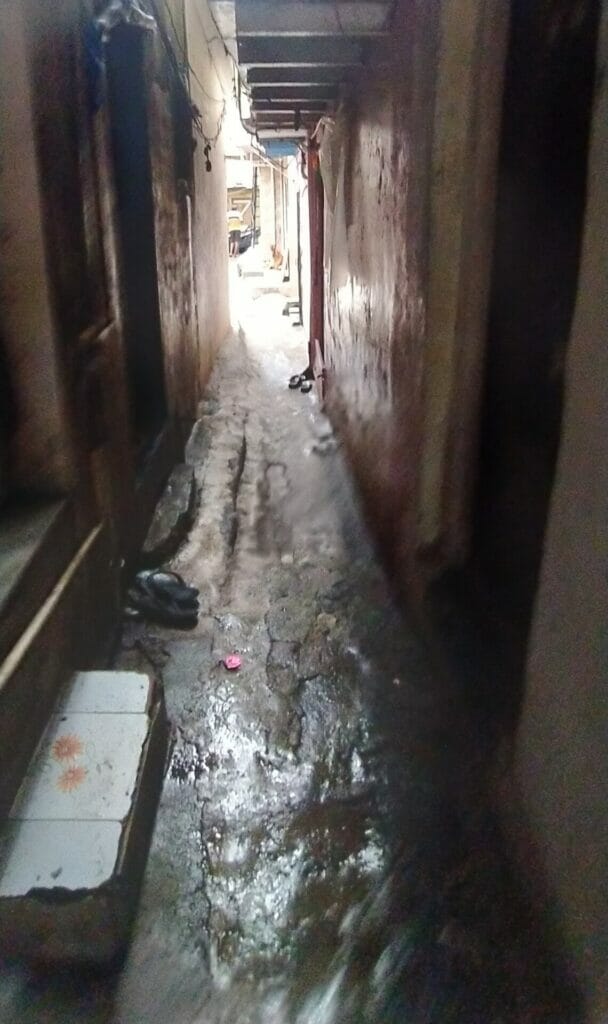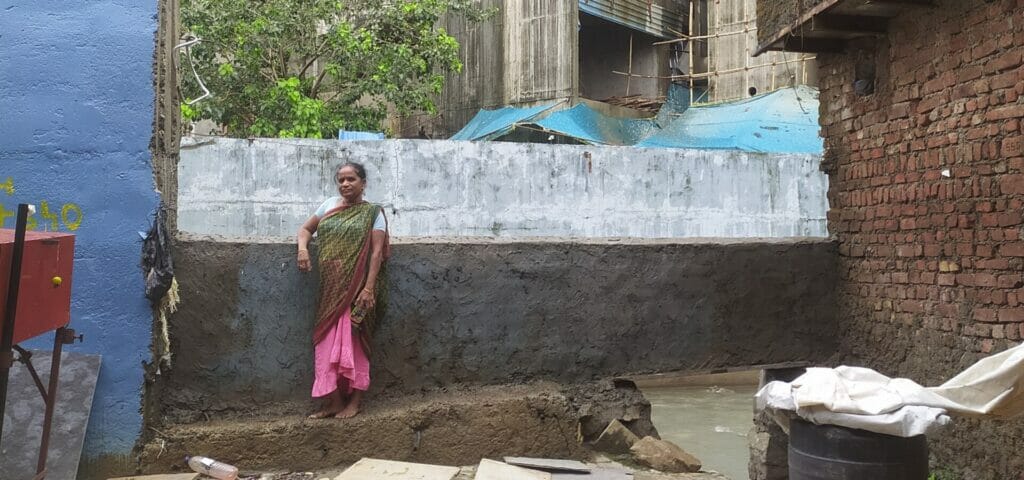Monsoon is a difficult time for the residents of Hanuman Nagar, especially those residing along the banks of the Poisar river. Officially, it may be the river, but practically it is a nullah or a storm water drain, which carries household garbage and even sewage waste.
As the rains intensify, the residents brace themselves for tough times. “It can flood anytime and we may not have enough time to save our belongings, so we start preparing as rains begin. We store our clothes in bundles, so that they can be thrown quickly to our loft to save them from flood waters,” says Anita More.
Safety instructions are in place her three children, aged eleven, six and three years. They have been asked to their relative’s house at a higher plane, in case of heavy downpour.
Her mother-in-law Vimal More, 60, who works at a neighbourhood school, keeps checking about water levels at home, each time it pours. Her workplace colleagues, aware of her precarious situation at home, allow her leeway to rush home during rain-related emergencies.
Their neighbours, Chaya Pawar, 58 family got so fed up with the rains, that they temporarily shifted to a rental house at a higher place just for the three months of last monsoons. However, it took a financial toll on them and this year they have chosen to stay put at their own house and face the monsoons.

Their neighbours, Prema Prakash, have already mounted their fridge atop a table, to safeguard it from the anticipated floods. She remembers the time when her fridge had literally floated in the flood waters few years ago.
Memories of floods and preparation
The overflowing Poisar river floods every year, only the extent varies. Every family living on the banks of the river has a traumatic experience, which is relived annually. In fact, the fear of the rushing waters, unites all residents and has developed a sense of solidarity among the local residents. People rush to help others, when the water levels in the nullah start rising.
Neighbours are alerted even if it is late at night and everyone pitches in to shift things on the loft and upper decks of houses. The children are accommodated in safer houses and people help with tea and food. “We have spent days without food because the muck made our kitchen stoves unusable, after the floods in 2021,” recalls Vimal.
Read more: Documentary portrays worsening floods in Mumbai over years
Sangita Vishwakarma, who lives a few rows of chawls away, recalls how she and her children were stranded on their loft, when waters rushed into their houses last year. The neighbours rescued them. Before that, her mother-in-law had been rescued by breaking the roof of the house open. Their flooring has multiple cracks – a result of their annual floods- that are temporarily repaired by cementing.
“We can’t really keep spending money on repairs because next monsoon the house will get more cracks. Our kitchen cabinets had to be completely redone after last year’s floods,” Sangita rues.
For people like Sangita, who shifted into this area after marriage, the Poisar river has always been a dirty nullah that brings in stinky, mucky waters in the floods. However, her neighbour, Aarti Mhatre remembers her childhood here, when the water was so clean that people would wash their clothes and even bathe in it.
Vimal too recalls that about five decades ago, the banks of the river had huge boulders and people would come over here for bathing and washing. But, back then, it did not flood. “The instances of floods due to rising water levels increased only after the river banks started getting concrete walls,” she recalls.
Story of the Poisar river
The journey of the 11.5 km long Poisar river from a pristine clear water flowing from the precincts of the Sanjay Gandhi National Park (SGNP), from Kandivli’s Appa Pada via Hanuman Nagar towards Marve creek, to its current state of being a filthy nullah carrying sewage and muck, hasn’t been a great one.
It is one of the four rivers in Mumbai – Mithi, Oshiwara and Dahisar rivers – that will be restored as part of the Mumbai river rejuvenation project.

The Chitale committee report that studied the 2005 Mumbai deluge had observed that encroachments on the riverbeds and banks of the Poisar river had choked and pinched the water course and aggravated the risk of floods. It also found that 55% of the river bank area had been encroached by slums, stables and unplanned housing development.
“Ingress encroachments from the banks (building, industries, and slums) as well as modification of river-course and local diversion of streams have compounded the risk of flooding,” the report said, noting particularly the “glaring encroachments” at Hanuman Nagar Road from the Wadarpada cemetery stretch.
The enquiry committee report also found that Poisar river also suffered from “debris dumping (from construction activities as well as industrial waste) on the banks, and dumping of municipal solid waste into river coupled with inadequate annual desilting efforts.”
It recommended that the city “restore the existing degraded rivers and river-banks to initiate recovery of the urban ecosystem” and suggested that access ramps be built into rivers from major roads and at critical locations to ensure proper desilting.
Read more: Explainer: Why we have urban floods and how to stop that
What is the BMC doing about it?
The BMC is in the process of building high walls alongside the river to prevent its water coming into the houses. However, the residents say that the new walls have failed to contain the floods.

In 2022, the BMC recommended a Rs 1192 crores Poisar river rejuvenation plan, that included building a 3,153 m long service road on the periphery of the Poisar river to facilitate its cleaning. The plan also includes building of 10 sewage treatment plants along the entire Poisar river with a capacity to treat 33.5 MLD (million litres per day) of sewage to ensure a cleaner river.
The Poisar river rejuvenation project also includes plans to develop 8.7 km of sewer network and 9.2 km of roadside drains equipped with 13 nullah interceptors and screens to block thrash from entering the river.
Is moving out inevitable?
The shifting of residents to new slum redeveloped buildings is the best long-term solution for them, feels assistant municipal commissioner of R-S ward Lalit Talekar. “Those staying along the river banks are in the process of being shifted to make way for the service road parallel to the river. Many SRA (slum redevelopment authority) projects are also in the offing here and that should help them get respite from the floods. The central agencies have undertaken many anti-flooding measures and the results should be visible soon,” says Talekar.
However, the delay in shifting to new SRA housing is getting harder for residents as floods are getting fiercer with every passing monsoon. Shifting into buildings on higher ground seems to be the only solution for the residents of Hanuman Nagar in their annual battle against climate change.